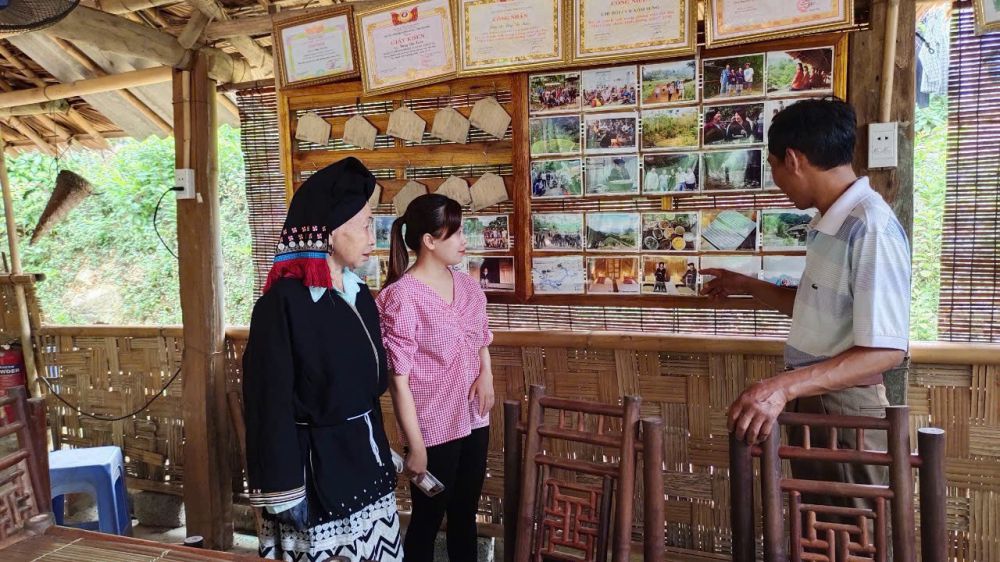Preserving the soul of the village
Sung Hamlet, Cao Son Commune, formerly in the mountainous district of Da Bac in the old Hoa Binh Province, is home to more than 70 Dao Tien households for many generations. The whole village is located in the heart of Bieu mountain, with pristine scenery and a cool climate all year round. Previously, Sung's isolated geographical location caused many difficulties in economic development. However, in recent years, thanks to promoting cultural advantages and landscapes, Sung hamlet has become a favorite destination for domestic and foreign tourists.
People still keep the traditional housework, dye the fabric, paint the beeswax to create patterns, and then weave costumes imbued with national identity. According to Ms. Ly Thi Nhat (a resident of Sung hamlet), there was a time when the brocade weaving profession of the Dao people was at risk of being lost. But since community tourism developed, the profession has been restored, taught to the younger generation and introduced to tourists.
"Not only is it a traditional profession of our Dao people, today, visitors are very excited to come to Sung hamlet to experience dyeing fabric, painting bee wax, and weaving brocade," Ms. Nhat shared.
Mr. Dang Van Xuan, the owner of a homestay in Sung hamlet, said: At first, when it was first opened for tourism, the village was still simple, only a few houses had been renovated to welcome guests. Now there are concrete roads to the village, homestays are more spacious, but people still maintain their old lifestyle, still dye indigo, weave fabric, and cook according to the way their ancestors passed down.
Currently, more than 70% of tourists coming to Sung hamlet are foreigners. They are not looking for high-end services but are attracted by closeness and rusticity such as trying on traditional costumes, participating in art troupes, bathing in cigarettes, and enjoying local dishes. "We understand that if we can't keep the original, customers won't come back. What they are looking for is traditional cultural values, Mr. Xuan emphasized.
In Pa Co commune, where the majority of the H'Mong people live, traditional culture of cuisine, accommodation, and costumes is also the foundation for developing community tourism. Once a drug hot spot, now Pa Co is becoming a popular "cloud hunting" spot. "pa co has a cool climate, the village culture is still preserved. People also restore traditional crafts such as growing flax and weaving brocade to develop tourism, said Mr. Phang A Cha, a commune official.
Pa Co 1 hamlet is currently the place with the strongest development of weaving. Of the 76 households, more than half are maintaining the brocade weaving profession. Ms. Sung Y Nong, one of the women who is attached to the profession, has almost completely switched from sewing to weaving. "When I was ten years old, my mother taught me to dye indigo, paint beeswax, and weave fabric to make national costumes. Now I pass it on to my daughter. "I have to protect my identity and earn an income to support my family," she said.
Not only Pa Co, many other localities in the old Hoa Binh land, now part of Phu Tho province, are also gradually developing community tourism based on indigenous cultural foundations. With more than 60% of the population being Muong, villages such as Giang Mo, Luy Ai or Xom Chien are becoming popular destinations. In Lac village, Van village - the place of residence of the Thai people - community tourism has also been formed early, maintaining a stable attraction. The common point in all these places is the way to preserve the lifestyle and cultural space typical of each ethnic group.

The living space carries the soul of identity
Not invested on a large scale, nor as bustling as resorts, but it is the sincerity of the people and the depth of culture that has helped the villages in the highlands of Phu Tho have their own position on the tourism map.
Ms. Minh Trang, a tourist from Hanoi, shared her unforgettable experience in Sung hamlet: I have been to many places, especially in villages of ethnic minorities. But in Sung, I was able to live like a real Dao Tien, and do my own dying of fabric and painting bee wax. Only when I do it do I see the meticulousness and ingenuity of the women here.
Many tourists choose to stay for a few days, work with the locals, dry sticky rice cakes by hand, go to the fields, or gather by the fire to listen to old stories.
Mr. Nguyen Van Thang, a tour guide, highly appreciated the potential of the old Hoa Binh land: "This area is adjacent to the capital, and has many ethnic minorities living together, so it is very diverse in culture and experience. But the core is to maintain identity. If tourism allowed the soul of the village to be swept away, it would lose all its value.
Realizing that, many localities are making efforts to preserve and promote indigenous culture in a systematic way. In Cao Son commune, the government organized community tourism training classes for people, supporting the construction of homestays in traditional architecture. In Giang Mo village, Muong women set up a cooking team, prepare traditional dishes to serve customers and pass on the craft to the younger generation. In Pa Co, the commune is coordinating with organizations to restore flaxseed, develop weaving, and experience eco-tourism.
In addition to cultural preservation, essential infrastructure such as roads, electricity, and water are also invested in. This is an important factor that helps community tourism have a solid foundation for development, creating livelihoods for local people.
When each village is a vibrant living space, with its own cultural soul, tourism not only brings income but also becomes a motivation for people to respect and preserve inherent values. And when culture is intact, tourism will have a long way to go more sustainably.











